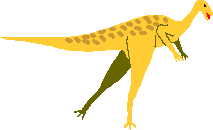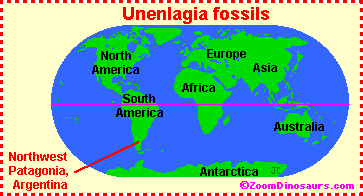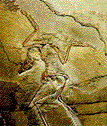Advertisement.
EnchantedLearning.com is a user-supported site.
As a bonus, site members have access to a banner-ad-free version of the site, with print-friendly pages.
Click here to learn more.
(Already a member? Click here.)
Unenlagia comahuensis!
Bird-like Dinosaur |
 The most bird-like dinosaur ever discovered is the 90-million-year-old Unenlagia comahuensis, a flightless, 4-foot tall, 7.5-foot-long carnivore. It is the size of an ostrich, but shaped like Velociraptor
The most bird-like dinosaur ever discovered is the 90-million-year-old Unenlagia comahuensis, a flightless, 4-foot tall, 7.5-foot-long carnivore. It is the size of an ostrich, but shaped like Velociraptor . Unenlagia had flexible arm movement (up and down movements were possible, like that which a bird uses in flying) - it could also grasp with its clawed, short, wing-like forearms. This new fossil helps show how dinosaur forearms evolved into the wings of modern-day birds.
. Unenlagia had flexible arm movement (up and down movements were possible, like that which a bird uses in flying) - it could also grasp with its clawed, short, wing-like forearms. This new fossil helps show how dinosaur forearms evolved into the wings of modern-day birds.
Unenlagia had a shoulder structure that allowed its short arms to move forwards, backwards, inwards (for grasping prey), and up and down (for a flapping motion). This flapping motion was not used for flying, because its wing-like arms were too short to support the heavy dinosaur. Perhaps these proto-wings were used for balancing, turning, and a bit of lift during high-speed running. Although there is no fossil evidence of feathers from Unenlagia, it may well have had them, further adding lift to each upstroke of the proto-wings.
 Twenty fossilized bones from Unenlagia were unearthed in an ancient river bed in the Patagonia region of Argentina (southern Argentina) by Fernando Novas, of the Museum of Natural History in Buenos Aires. Novas named the fossil Unenlagia comahuensis, meaning "half bird from northwest Patagonia," in a combination of Latin and the language of the local Mapuche Indians. Novas' discovery is described in the May 22, 1997, issue of Nature.
Twenty fossilized bones from Unenlagia were unearthed in an ancient river bed in the Patagonia region of Argentina (southern Argentina) by Fernando Novas, of the Museum of Natural History in Buenos Aires. Novas named the fossil Unenlagia comahuensis, meaning "half bird from northwest Patagonia," in a combination of Latin and the language of the local Mapuche Indians. Novas' discovery is described in the May 22, 1997, issue of Nature.
Unenlagia comahuensis was a theropod from the mid-Cretaceous, living about 90 million years ago. The first birds appeared 150 million years ago, evolving from dinosaurs long before Unenlagia lived. Therefore, it is not an ancestor of modern-day birds, but was an evolutionary dead-end.
Unenlagia's shoulder and arm design provide evidence relating to the origins of flight. Paleontologists have debated about the origins of flight. Did animals first leap from trees and glide, or flap and rise from the ground? Unenlagia's bone structure supports the latter theory, in which animals start from the ground up. On the other hand (or proto-wing), Unenlagia might have evolved, like the ostrich, from an earlier flying dinosaur; after all, birds had existed for over 60 million years already when Unenlagia lived.
OTHER DINOSAUR-BIRD FOSSILS
 Birds probably evolved from the maniraptors
Birds probably evolved from the maniraptors , a branch of bird-like dinosaurs. The Archaeopteryx is the oldest known fossil bird, and dates from the late Jurassic period (about 150 million years ago), now extinct. Although it had feathers and could fly, it had similarities to dinosaurs, including its teeth, skull, and certain bone structures.
, a branch of bird-like dinosaurs. The Archaeopteryx is the oldest known fossil bird, and dates from the late Jurassic period (about 150 million years ago), now extinct. Although it had feathers and could fly, it had similarities to dinosaurs, including its teeth, skull, and certain bone structures.
 The first Archaeopteryx fossilized feather
The first Archaeopteryx fossilized feather  impression was found in 1860 in a limestone quarry in Germany. A year later, a much more complete fossilized Archaeopteryx was found at the same quarry. Impressions of its feathers and bone structure were quite clear. Many more have been found since.
impression was found in 1860 in a limestone quarry in Germany. A year later, a much more complete fossilized Archaeopteryx was found at the same quarry. Impressions of its feathers and bone structure were quite clear. Many more have been found since.
In 1868, Thomas Henry Huxley interpreted the Archaeopteryx fossil to be a transitional bird having many reptilian features. Using the fossils of Archaeopteryx and Compsognathus, a bird-sized and bird-like dinosaur, Huxley argued that birds and reptiles were descended from common ancestors. Decades later, Huxley's ideas fell out of favor, only to be reconsidered over a century later (after much research and ado) in the 1970's.
Bird fossils are rare because bird bones
are rare because bird bones are hollow and fragile, but Jurassic, mid-Cretaceous, Eocene and Miocene-Pliocene bird fossils have been found.
are hollow and fragile, but Jurassic, mid-Cretaceous, Eocene and Miocene-Pliocene bird fossils have been found.
 Information Sheets About Dinosaurs Information Sheets About Dinosaurs
(and Other Prehistoric Creatures) |
Just click on an animal's name to go to that information sheet. If the dinosaur you're interested in isn't here, check the Dinosaur Dictionary or the list of Dinosaur Genera. Names with an asterisk (*) were not dinosaurs.
How to write a great dinosaur report.
For dinosaur printouts, click here.For brief dinosaur fact sheets, click here.
Enchanted Learning®
Over 35,000 Web Pages
Sample Pages for Prospective Subscribers, or click below
Click to read our Privacy Policy
Enchanted Learning Search
|
Search the Enchanted Learning website for:
|
Advertisement.
Advertisement.
Copyright ©1996-2018
EnchantedLearning.com ------ How to cite a web page


